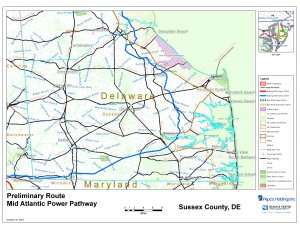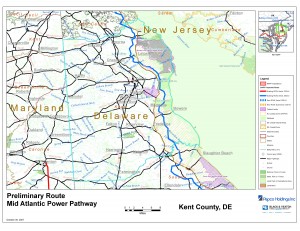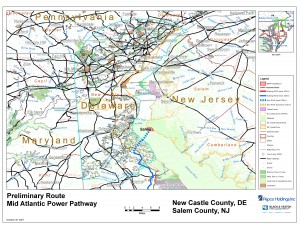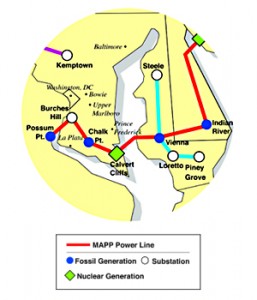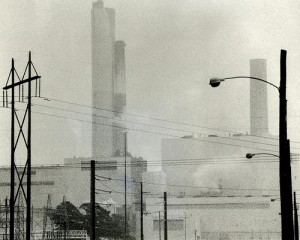Sussex Co. transmission meeting tonight
February 4th, 2009
Tonight is the final meeting in the group scheduled by Delmarva Power about the Mid-Atlantic Power Pathway, transmission through Delaware to New Jersey.
Wednesday, February 4 @ 6 p.m.
Millsboro Civic Center
322 Wilson Highway
Millsboro, Delaware
Sussex County:
Kent County:
New Castle County (cutout):
For more info on the underlying scheme, see my prior post:
Delmarva Power to hold transmission line meetings
January 22nd, 2009
MID-ATLANTIC POWER PATHWAY?
JUST SAY NO TO TRANSMISSION FOR COAL AND NUCLEAR.
Delmarva Power will be hosting three meetings in Sussex County on the MAPP transmission line, no not MAPP of “MAPP map” fame, but Mid-Atlantic Power Pathway, a big line designed to bring coal generated electricity through Delaware, and take Delaware’s Indian River coal generation north east into New Jersey.
Times, dates and locations for community meetings:
Tuesday, January 27
Delmar Fire Hall
Bi-State Blvd. & Grove St.
Delmar, Del.
6 p.m. to 8 p.m.Thursday, January 29
Gumboro Fire Hall
37030 Millsboro Highway
Gumboro, Del.
6 p.m. to 8 p.m.Wednesday, February 4
Millsboro Civic Center
322 Wilson Highway
Millsboro, Del.
6 p.m. to 8 p.m.
Delaware is way behind in transmission regulation. Unlike most states, Delaware does NOTHING at all to regulate transmission — there’s no Certificate of Need or Certificate of Public Convenience and Necessity required, they do NOT have to demonstrate that the line is needed. And there’s no PSC routing proceeding either. In most states, they DO have to demonstrate need or the line cannot be built, and the line must be for a public purpose. For the MAPP line, which is bulk power transfer, MARKET TRANSACTIONS, there’s no public purpose here, just private purpose, corporate profit. There’s nothing in it for Delaware. Well, it does enable NRG to move its coal generation around more easily.
You may hear claims “it’s for wind” and that is a crock. You may have heard Jeremy Firestone say that this line is designed for coal and nuclear, but could be designed to help wind development in Delaware — Jeremy Firestone may be the wind guru, but Firestone’s outside his area of expertise and his failure to say “SHUT DOWN INDIAN RIVER” comes through loud and clear. Here’s Firestone and Kempton’s comments about MAPP from Bluewater Term Sheet comments:
NO NO NO, that only enables coal and nuclear. Whatever are you thinking?
Delaware Electric Cooperative has said that it wants to build a NEW North Anna nuclear plant — is that still DEC’s plan? If so, the MAPP line would get that nuclear power there, and all DEC customers would be participating in nuclear expansion. Is that what you want? This is an issue for Sussex county to weigh in on now!
Shutting down NRG’s Indian River Generating Plant is the logical step to help wind development in Delaware, both in market development and transmission access. And of course it’s the logical step to reduce toxic emissions in Delaware — the Indian River Generating Plant is the largest point-source polluter in Delaware. To quote Muller: DELAWARE NEEDS TO STOP BURNING COAL.
How would shutting down the Indian River plant enable wind? Indian River’s two smallest plants will be shut down in 2009, and removal of that generation leaves enough transmission infrastructure generation and reservations for the Bluewater Wind project. If Indian River was completely shut down, there’s room for a lot more off-shore-wind generated electricity than Bluewater plans — several times the MW of the Bluewater Project. Let’s get to it — shut down Indian River now — and if NRG’s bid for gas generation to back up wind is approved, that would be sited there — just the right place back up wind and provide reactive power for the system.
And a little sidebar — though many Renewable Energy Standards passed, ALL have a fatal flaw — not a single one is linked to any shut down of fossil fuel generation. So for a 25% RES, we’re looking at adding that above current generation, not cutting generation, so the numbers look like this: 100% demand + 25% RES = 125% rather than 100% demand -25% fossil fuel + 25% RES = 100%. That may seem simple… so why are all RES’s missing this important connection?
What this MAPP line does is enable coal generation from the other end of the line and coal generation at Indian River to continue, and to be sold on the market, so that even if Delaware does not use the generation, they can sell it elsewhere. Even if CO2 externalities add to the cost, on the spot market they can sell it anywhere and still make a lot of money. Yeah, good idea.
Once more with feeling — Two points here:
1) SHUT DOWN ALL OF NRG’S INDIAN RIVER COAL GENERATING PLANT AND MAKE ROOM FOR WIND!
2) JUST SAY NO TO TRANSMISSION FOR COAL!
Here’s Delmarva’s blurb published nearly verbatim in the Sussex Countian:
Here’s the Delmarva from a PR service:
Mid-Atlantic Power Pathway Meetings Scheduled for Sussex County, Del.
Times, dates and locations for community meetings:
Tuesday, January 27
Delmar Fire Hall
Bi-State Blvd. & Grove St.
Delmar, Del.
6 p.m. to 8 p.m.Thursday, January 29
Gumboro Fire Hall
37030 Millsboro Highway
Gumboro, Del.
6 p.m. to 8 p.m.Wednesday, February 4
Millsboro Civic Center
322 Wilson Highway
Millsboro, Del.
6 p.m. to 8 p.m.
Open House – Xcel’s Hiawatha Project
January 17th, 2009
Thursday afternoon and again in the evening, Xcel held an Open House for its proposed “Hiawatha Project,” transmission through Phillips.
What I learned:
From Pam Rasmussen: Conductor specs — 795 ACSS DOUBLE CIRCUIT and NOT bundled. But there’s not much impact on the capacity, it’s essentially the same. Here’s the conductor spec chart, where you can look up 795kCmil on the left and then go over to the right to 115kV — remember this is for 1 circuit, so for 2, double it — this is from the SW MN 345kV case:
From Dave Callahan: The area on Hiawatha where they’re looking at sticking a substation is North of Lake, on the East side of Hiawatha, where the northwest end of that Target complex abuts another group of buildings on Minnehaha backing up to Hiawatha. There’s no road access, and there’s been talk of extending the Midtown Greenway from a bit north through this area towards Lake Street. It sounded like Xcel had already had discussions of how to put a substation there and leave room for the Greenway expansion. As there’s no road, the easiest way I see to get there is to start at Cedar and head east on Hiawatha, tromp on it to get some lift and do an Evil Kinevil over Hiawatha and land there… otherwise, try walking from Minnehaha. It’s just to the right of the “A” below:
Recently, Xcel had announced that its preferred route is along the Midtown Greenway. In looking at routes, and digging through my files, I’d discovered the Metro Load Serving Study from 2001. That study says, about plans for South Minneapolis: Oh my, LOTS about South Minneapolis, I’m going to have to do a whole separate post on that. Manana…
At the July 24, 2008, NM-SPG meeting, there was this presentation, per the minutes:
7.1.4. South Minneapolis
Mr. Standing, XCEL, presented the South Minneapolis Electric Reliability Project (SMERP) study. Mr. Standing stated 4 options were studied. The preferred option includes a new 345 kV line in-service in approximately 2013-2020 from the New Hwy 280 345/115 kV substation to the New Hiawatha substation.
And from the 2007 Biennial Transmission Plan, we have this snippet that gives us a peek at their plans:
That section of the 2007 Biennial Transmission Plan is just too big. CLICK HERE and click on section 7.5 and scroll down to the 3rd and 4th to the last pages.
In that section of the 2007 Transmission Plan, it describes a “need” in South Minneapolis:
Are you paying attention? The “inadequacy” is in the 12.4kV distribution system. Or the “inadequacy” IS the 12.4kV distribution system. Also note that they are forecasting a load growth of 100MW over the next 10 years. Don’t forget these points.
When you take the plans that are out there for the taking, and sketch them out, here’s what it looks like (this is old news, but once more with feeling):
Xcel, when you’ve got an inadequacy with your 12.4kV distribution system, and power quality issues at some of the big electric users, why would you think that this big linked addition of transmission is the answer. How about trying a distribution upgrade — isn’t it long overdue? And underground that distribution while you’re at it!
Xcel’s Hiawatha Transmission Project Open House TODAY
January 15th, 2009
Xcel announced yesterday that its preferred route for the “Hiawatha Project” is on the rim of the Midtown Greenway.
Today Xcel is holding two open houses on its “Hiawatha Project” and that’s one way to find out what Xcel is planning — but what they’re stating as the “project” is only a small part of what’s planned for South Minneapolis.
Xcel Open Houses
Plaza Verde
1516 E. Lake St., Minneapolis
12- 2 p.m. & 5-7 p.m.
Here’s the rest of the story, what I’ve learned of Xcel’s plans from public information — here’s what it will look like, with routing variations, but at least part of their intent:
(can’t get the map right… grrrrrrrrr)
High-voltage line proposed along Midtown Greenway
By STEVE BRANDT, Star Tribune
January 14, 2009
Xcel Energy is proposing to route a high-voltage power line along the border of the Midtown Greenway, crossing the recreational corridor four times, and is seeking public reaction to the plan today.
The proposal to beef up Xcel’s transmission capacity in the Lake Street corridor has kicked up concerns among those who question the need for the line and worry about possible health effects and the visual impact.
But the utility said it needs to offer more reliable service in the area, which has redeveloped with denser housing and with once-vacant businesses now occupied.
Xcel is proposing an aerial line, which is cheaper but runs counter to the sentiment of area council members that the line should be buried. They prefer a route under E. 28th Street if the line goes ahead.
Betty Mirzayi, Xcel’s transmission project manager, said Xcel chose the route largely following the Greenway’s south rim because it’s a more direct route that would be cheaper to build. Xcel also looked at overhead routes along E. 26th, 28th and 31st streets for the east-west extension from its existing Hiawatha Avenue transmission line into the redeveloping Midtown area. But those routes would run closer to more houses, partially block sidewalks with poles and require removal or pruning of more trees, she said.
Mirzayi said Xcel also evaluated an underground alternative for the Greenway route. She said that the $15 million project includes $2 million for installing overhead lines. Burying the line along the Greenway corridor would cost $15.8 million more, a cost Xcel said would be borne by ratepayers.
But Council Member Robert Lilligren said he is concerned that an overhead Greenway line would discourage redevelopment, the reason that the city and county invested in the Greenway.
Xcel proposes to locate a new substation on the east side of Hiawatha at 28th Street, adjoining its current transmission line. A prime attraction of that site, now owned by the state and a railroad, is that it is away from homes and offers room for expansion, Mirzayi said. Xcel proposes to expand an old unused substation on Oakland Avenue S., purchasing an adjacent condemned triplex and a vacant lot.
The Midtown Greenway Coalition, an advocacy group with membership from neighborhoods bordering the bike-pedestrian corridor, has opposed the project for now. It said it would reassess that position if alternatives for improving the area’s power supply prove inadequate and there is adequate buffering of the line. Tim Springer, the coalition’s director, said the proposed routing makes finding alternatives such as conservation or load management even more important.
Mirzayi said the Greenway rim route leaves adequate room in the former rail trench owned by Hennepin County for the potential development of trolley or light-rail transit.
The company has delayed its project timetable somewhat, pushing back its application to the state for the project from this month to later this winter. It now hopes to begin using the line and two accompanying substations in the first half of 2011.
Power Plant Siting Act Annual Hearing
January 2nd, 2009
The Annual Hearing for the Power Plant Siting Act was on Tuesday, it was a LONG trip to get there, including an alternator that died, and was resurrected after the rebuilt one didn’t work, rebuilt from the new and the old in the back of the Subaru in a parking lot in Everett, PA. The good news is that the room was full — but why are so many people going to this and NOT SAYING ANYTHING? What’s that about?
Anyway, Comments are due on February 2, 2009, Groundhog Day. Send Comments on how you think the PPSA is and is not working to:
Bob Cupit
Public Utilities Commission
101 E. 7th Place, Suite 300
St. Paul, MN 55101
or email to bob.cupit [at] state.mn.us
The Power Plant Siting Act was part of Minn. Stat. Ch. 116C, but now it’s 216E…
Here’s the point of the PPSA Annual Hearing:
